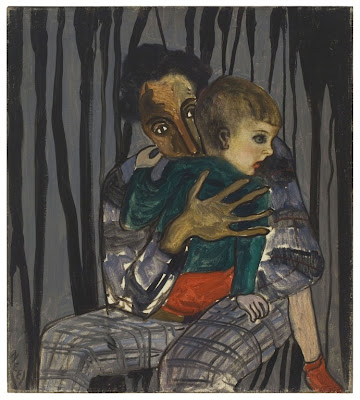I first ran across Stuart Semple's paintings in a 2007 group exhibition "The Black Market." The earlier paintings attracted my attention for their graphic styling and skillful paint handling. Semple is a multifaceted entrepreneurial artists working in several venues, but in order to keep things simple I am only going to address the paintings.
Semple's paintings do possess certain stylistic affinities with the artists of 20th Century Pop, Warhol and Koons have been suggested by some. However the essence of his approach is significantly different from his historical antecedents.
Pop Art in the last century came at the tail end of the Modernist Era (Modernism, including Postmodernism) Viewed from a functional point of view, Pop Art was a methodology which reintroduced the representational image back into advanced painting, the old avant guard.
In this process, the Pop artists utilized images from the culture in the same way they might have used nature, as a still life, rendering them as iconic. The crossover influences of formalism are evident, in particular in certain paintings by Warhol, Lichtenstein and Rosenquist.
While still present by insinuation, narrative was downplayed in favor of a formalist or iconic approach with a ample dash of irony thrown in to fend off the Avant Guard and Kitsch [1] [2] crowd with their elitist ideas that Art belonged solely to the upper class. It is ironic that Pop Art became the most widely popular style of art in the 20th Century.
Today, a young artist looking back upon the early years of Pop Art, might realize the process is similar to the Pop artists looking back at the start of Cubism, it seems so near, yet so far away. The cultural context is continuously changing and Pop Art no longer can exist in the way it did 40 years ago, our acceptance of the cultural image has become commonplace.
In todays world, advertising has lost the fascination it may have had in the middle decades of the last century. We are overstimulated by an exponential increase of media images to the extent that we now may find them repulsive, or at least the target of our criticism.
Yet, what Greenberg labeled as Kitsch:
"popular, commercial art and literature with their chromeotypes, magazine covers, illustrations, ads, slick and pulp fiction, comics, Tin Pan Alley music, tap dancing, Hollywood movies, etc., etc."describing it as
"a product of the industrial revolution which urbanized the masses of Western Europe and America and established what is called universal literacy."is rapidly becoming the source for a new mythology. A mythology transmitted through the technological media rather than an through an oral tradition as the information revolution puts an end to Modernism and the industrial age.
Irony is a device artists can use to introduce elements, symbols or ideas into an artwork without taking direct responsibility. A slight of hand. This is not a value judgment but an observation of the process.
In his work Stuart Semple utilizes Pop styling, the familiar connection with commercial imagery but without the irony. It's not that there are no bits of recursive visual humor, like the hand painted emulation of the printing process, but overall, I had the sense that Semple takes responsibility for his images, their juxtaposition and their virtual narrative.
Also characteristic of 21st Century Pop, Semple uses commercial imagery without celebrating the subject nor reducing it to just another layer of imagistic texture like the painter Albert Oehlen.
The media references, visually or as subject matter, act metaphorically allowing the viewer a point of entry into the painting without necessary knowledge of the artists private world. It is a form of enabling, similar for example, to ones ability to locate costume in time, we accept this knowledge and move deeper into the metaphor.
Semple's stylistic choices, his use of media references and styling, help to locate his paintings in the near present. With hints of film noir his paintings present a contextual experience which moves the viewer beyond the purely visual into the more literary realms of psychological associations and memory. No painting is complete in itself, it needs a viewer to close the circle of experience.
I've looked at a lot of paintings by young artists over the last month or so, most are competent cookie cutter variations of the current painterly zeitgeist. I felt Stuart Semple's exhibition was an exception. While I personally favored some paintings over others the overall direction his work is taking is fresh and interesting. It bears watching and is collectible.

Stuart Semple
For The Broken, 2009
Acrylic, charcoal and vinyl on canvas
47.25 x 47.25 x 2.75

Stuart Semple
Do you want to know... know it doesn't hurt me?, 2009
Acrylic, charcoal, chalk, spray paint and paintmarker on canvas
67 x 94.5 x 2.75 inches

Stuart Semple
Wanted To Believe In Something, 2008-2009
Acrylic, charcoal, chalk, household gloss and sanguine oil on canvas
47.25 x 47.25 x 2.75

Stuart Semple
Angelus, 2009
Acrylic, charcoal, chalk, graphite, vinyl. and paintmarker on canvas
67 x 94.5 x 2.75 inches

Stuart Semple
Everybody Sees You're Blown Apart, 2009
Acrylic, vinyl, charcoal, chalk and paintmarker on canvas
86.5 x 86.5 x 2.75 inches

Stuart Semple
Ding Dong (Maggie's Dead), 2009
Mdf, plastic, gloss paint, leather and electronics on aluminum
65 x 83 x 47 inches (overall dimensions)
Earlier works from "The Black Market" exhibition" at Anna Kustera Gallery in the summer of 2007.

Stuart Semple
Kurt Lied, 2007
Mixed media on canvas
47 x 35 x 3 inches

Stuart Semple
Sacharine, 2007
Mixed media on canvas
47 x 35 x 3 inches
All photo's ©Stuart Semple.


















